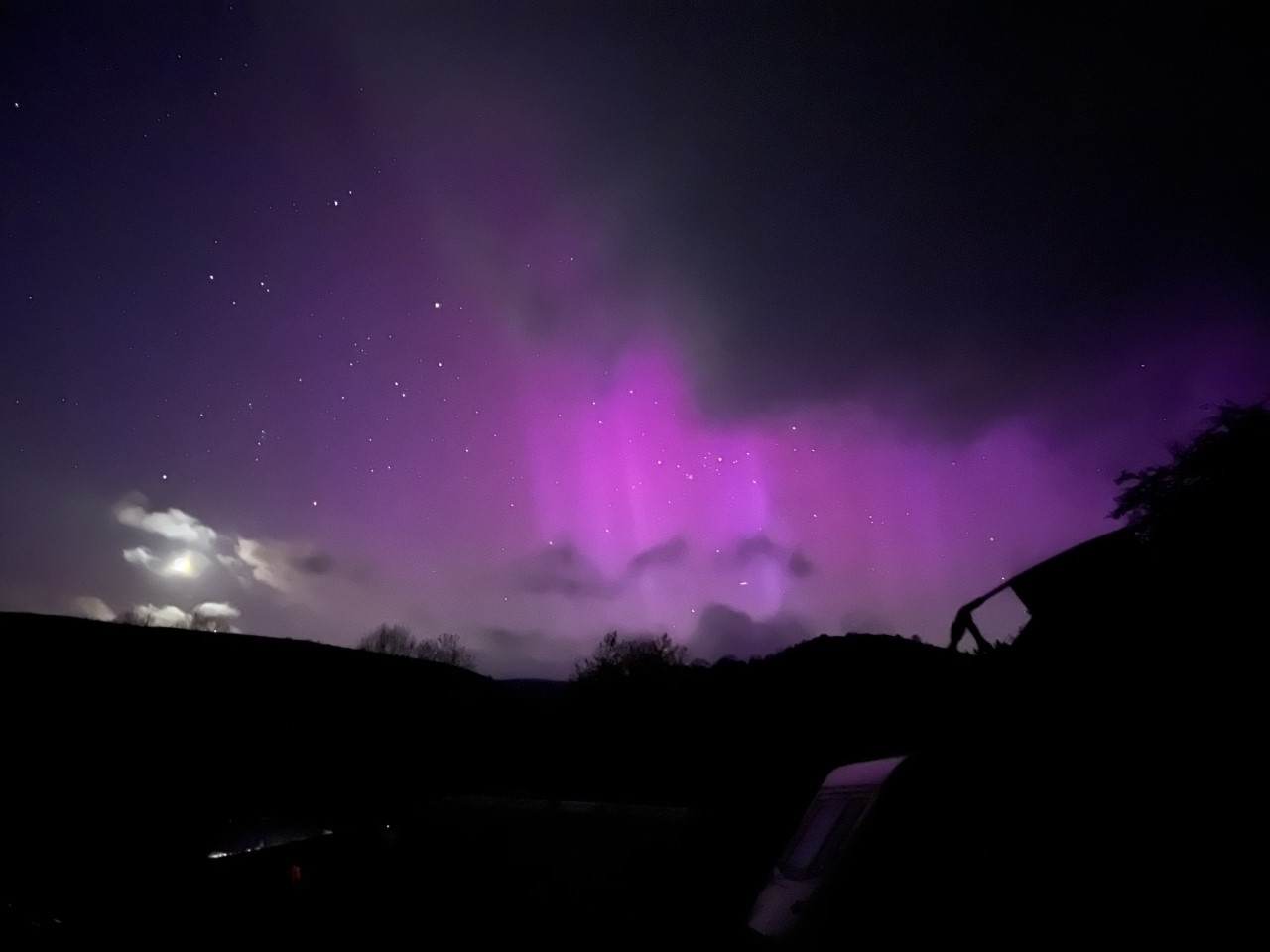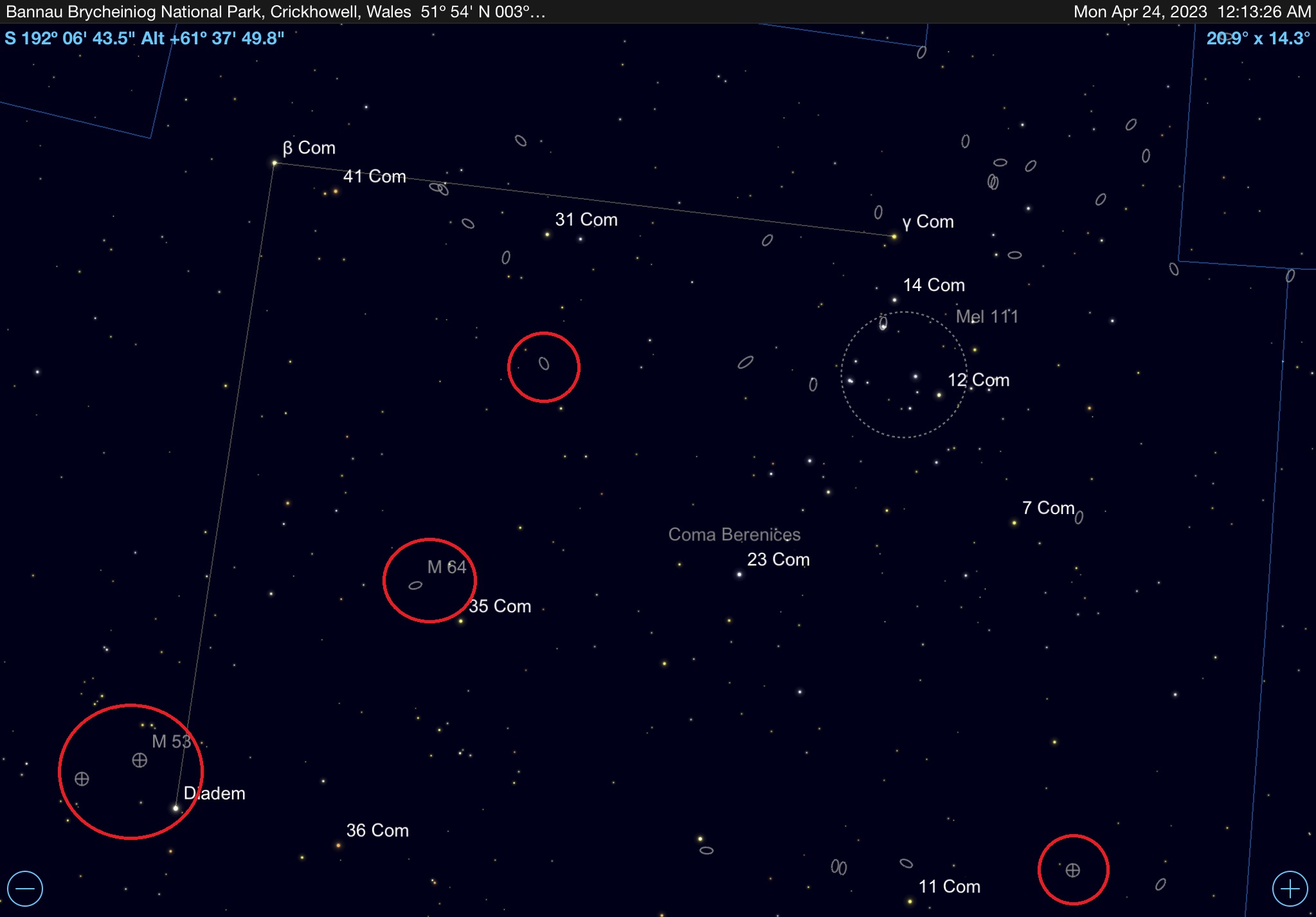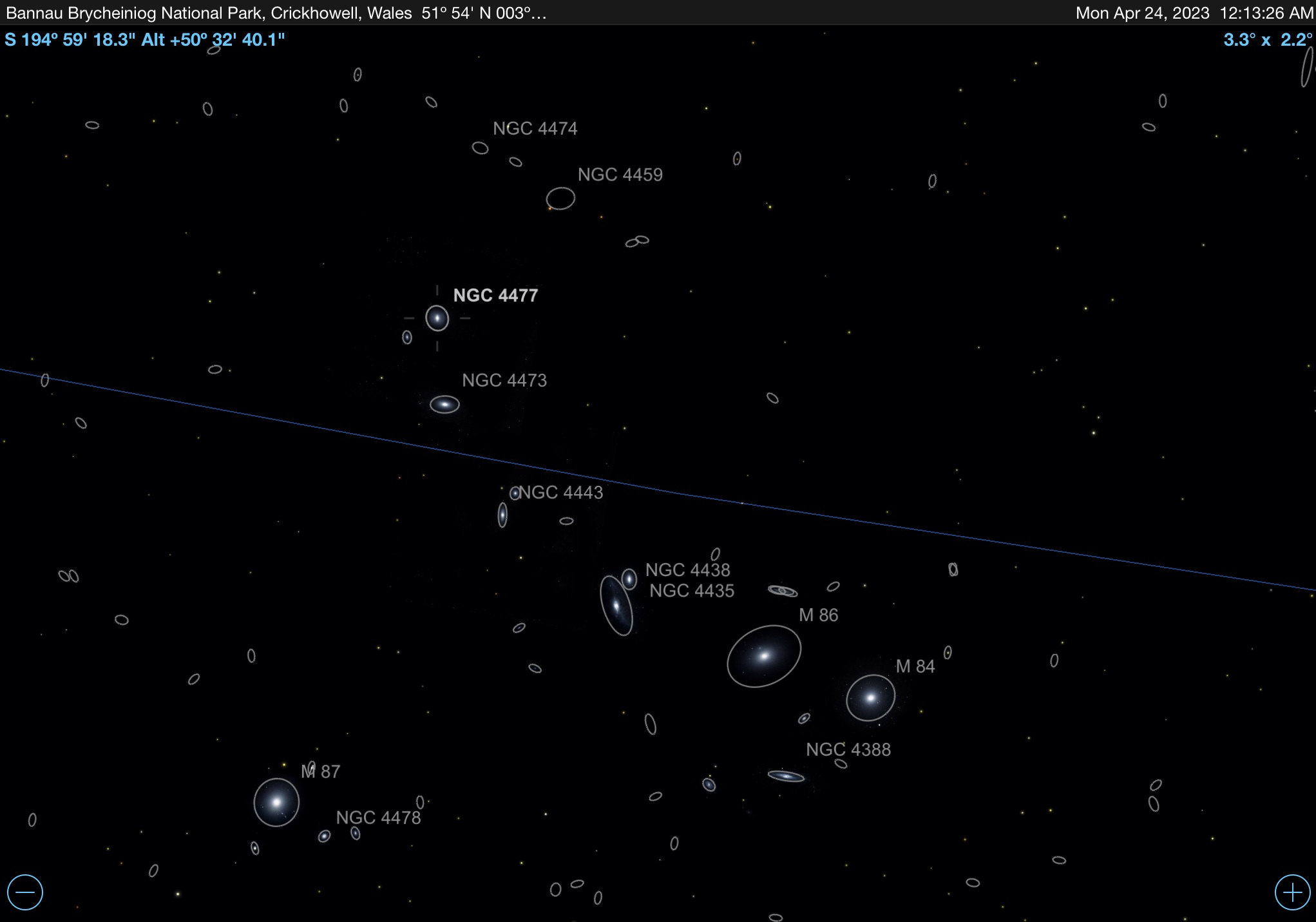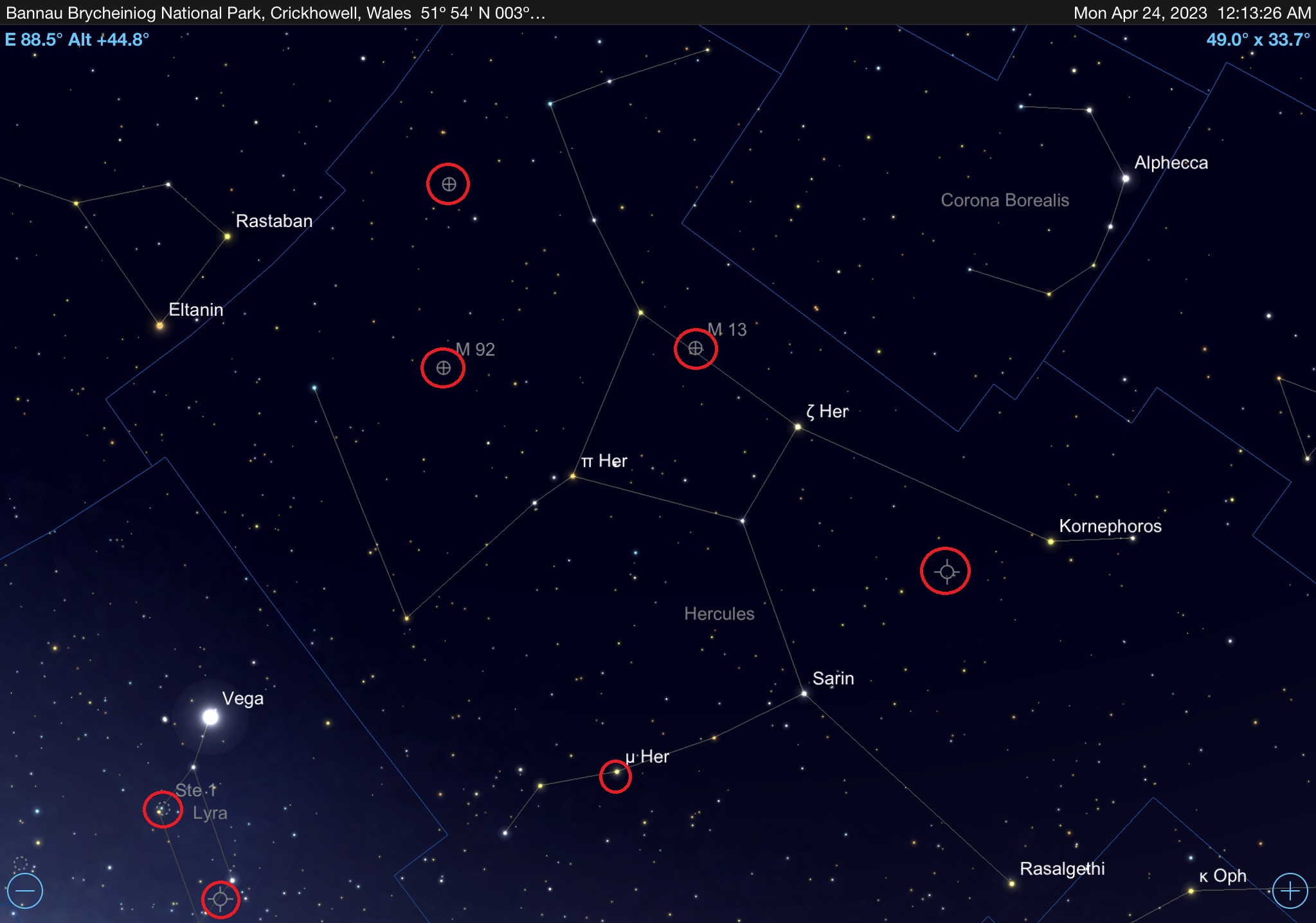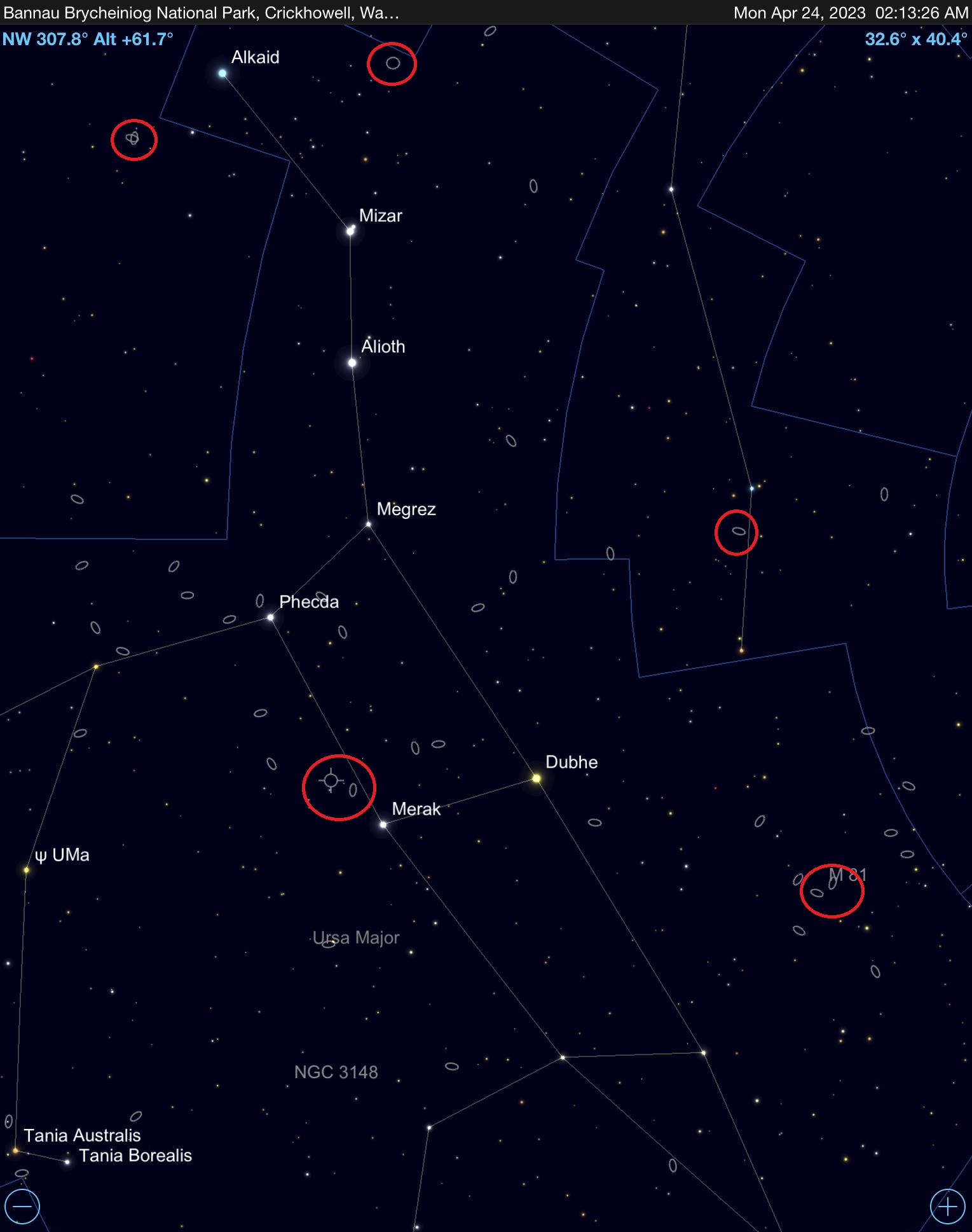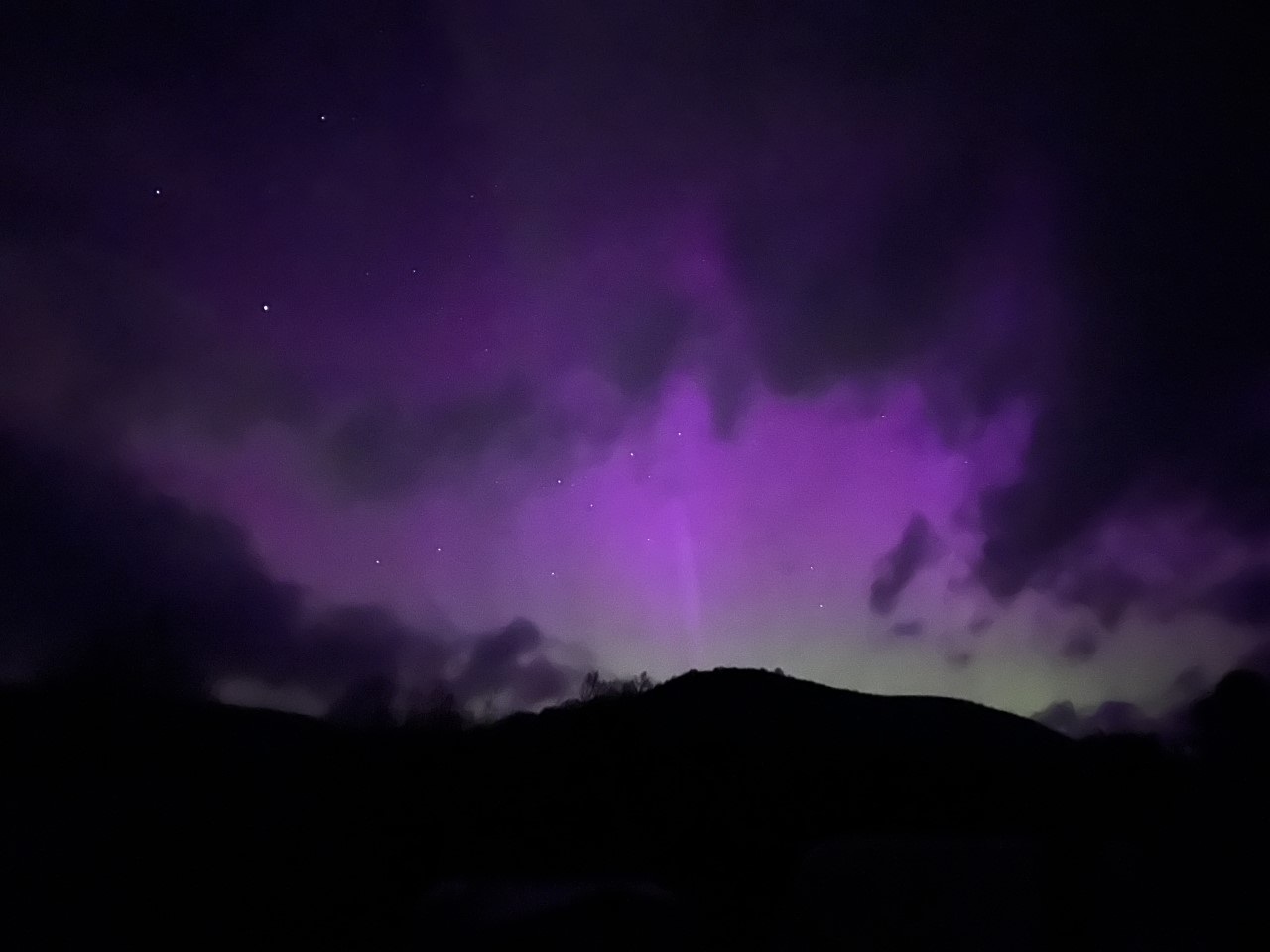Thanks to a very busy period at work, I failed to complete any of my usual preparations for Astro Camp including creating a target observing list. In fact, I just grabbed the first telescope I could get my hands on in the hours before leaving for Wales, which I had used at the most recent meeting of the Baker Street Irregular Astronomers a few days before and was still in a case with a selection of eyepieces. However, the APM LZOS 105 F/6.2 triplet Apo is a veteran of a couple of Astro Camps past and was packed with four excellent eyepieces; the Tele Vue 21mn Ethos (31x magnification / 3.2o field), the Tele Vue 14mm Delos (46x / 1.5o) and 10mm Delos (65x / 1.1o), as well as the Tele Vue Nagler 3-6mm Zoom (108x-216x / 0.45o – 0.23o).
Setting up on the Common at Camp on Saturday, my mind wondered back to the lack of observing list when I overheard someone mention the Spring 2023 Welcome Pack. In my occupied state in the days before camp, I had not even downloaded the guide and knowing that a range of recommended objects for visual and imagers was always included, that seemed to be as good as a place to start as any. As it transpired, I need not have worried about a lack of target list as the organisers had gone above and beyond this time with a curated list of 42 targets dubbed the Cwmdu Bannau Brycheiniog Marathon – a two-part whole-sky adventure mix of old favourites DSOs as well as some off the beaten path. Part two will be in the offering for the autumn camp. As I reviewed the list, I realised it was a great mix of eyepiece showstoppers and slightly more obscure DSOs which seemed to have an interesting astrophysical story attached to them. Knowing something about the object in the field of view has always added a little extra to the sight in my mind, so my spring camp destiny was set. I would attempt the marathon. While Saturday was clouded out, Sunday forecasts offered promises of clear skies as dusk approached and would be sustained well beyond midnight.
The target list was arranged in RA order so you work your way across the sky from West to East. The indicated time slots would place the objects well towards the South-West and I decided to follow the list as it was presented.
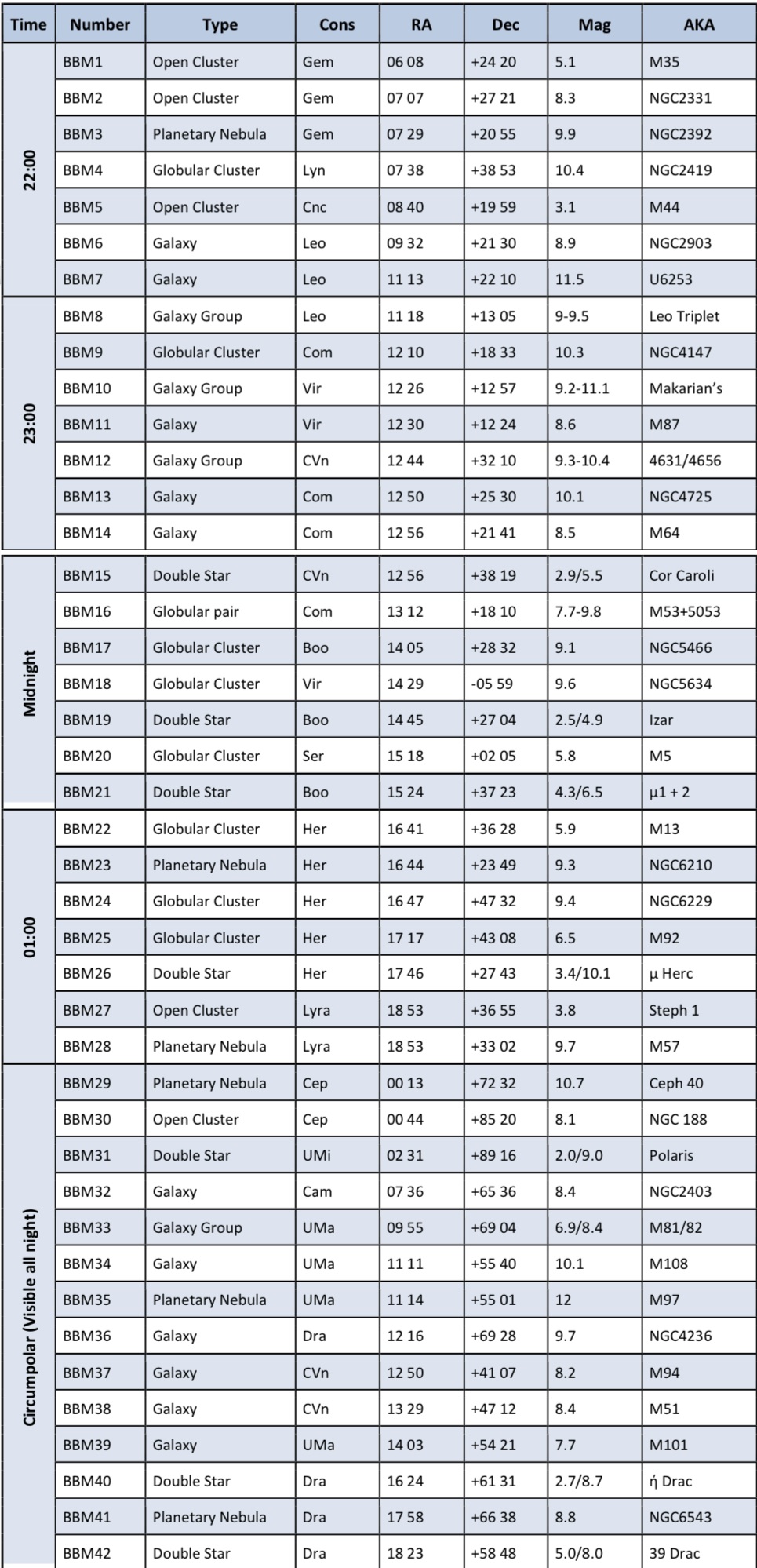
The Cwmdu Bannau Brycheiniog Marathon Spring Target List. Source: Astro Camp Spring 2023 Welcome Pack
The 22:00 to 23:00 Targets
Nautical Dusk would not arrive until 21:47 and Astronomic darkness almost an hour later. However, a large bank of clouds had slowly approached to the East over the hill and looked like they may torpedo a night of stargazing. Not wishing to lose even a minute, I started hunting down the BBM42 at 21:35 in a deep blue sky in the west. Fortunately, BBM1 is a bright showpiece that shone through the twilight sky. Using Propus (a great double star test for a 4” class scope given the narrow separation and 3 magnitude difference) at the foot of the twin Castor as a starting point, it was a simple sweep 2-degrees west to find M35. Using 65x, two loops of stars appeared connected by a narrow star bridge of mostly unresolved stars, itself peppered with brighter cluster members. One of the loops had two arcs of stars spiralling away in opposite directions.
BBM2 was also easy to locate in slowly darkening sky. Mars is currently sitting in Gemini just below Wasat to the west and Tau Geminorum to the east. At only 2o 50’ from the god of war, NGC2331 was in the field of view of my 21mm Ethos when Mars was placed towards the bottom of the field. Switching back to the 10mm, the cluster was random scattering of 25-30 stars with an indication of a zigzag pattern orientated north-south along one side of the cluster.
An old favourite was up next. BBM3, better known as the Eskimo Nebula (NGC 2392) thanks to the appearance of face snuggly wrapped in a parka was easy using the 21mm Ethos by placing Wasat near the field stop, the distinctly non-stellar planetary nebula, even at this low magnification was obvious on the other side of the field. Using the 5mm setting of the zoom showed the central star surrounded by an oval inner and circular outer halo, both exhibiting a greenish tinge though this was more intense for the inner structure.
The fourth object on the BBM was the first I had to look up and the first that gave me some trouble (especially given I was hunting it in a not completely dark sky). It is also when I realised that some of the targets where astro-physically interesting rather than showpieces. Discovered by William Herschel on New Years Eve 1788, NGC 2419 is known as the Intergalactic Wanderer. It is one of the most remote Milky Way Globular Clusters at a distance of 300,000 light years (twice that of Large Magellanic Cloud) taking 3 billion years to orbit the galaxy. The nickname was bestowed upon this distant member of the MW when it was incorrectly assumed not be in orbit. Dim because of distance it may be, but intrinsically, this GC would rival Omega Centauri in absolute brightness. Starting with Castor towards the field stop of my 7×50 (6.3-degree field) finder meant magnitude-5 star 65 Aurigae was close to the edge of the finder view on the opposite side. Panning the scope to move this star to the 6-oclock position of my finder moved BBM4 to the edge of 14mm Delos. While my eye immediately honed in on something that was non-stellar it then seemed to vanish from view. Unsure I had moved the scope correctly; I reset to Castor and repeated the movement…. Three more times. Apologies to Olivia who was waiting patiently to look at this object, but I could not convince myself I was seeing the distant globular. By the time I did have it, no doubt helped by a darkening sky, she had wandered off, much like MMB4 itself. Definitely not a gasp inducing sight, at 65x there was a dim, circular glow with perhaps a hint of brightening towards core and a slightly irregular, wavy pattern on one side of the cluster edge. Unimpressive maybe, but all the more impressive when you remember it is 300,000 light years distant.
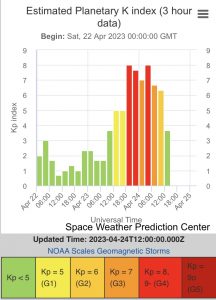
The estimated KP index after in the time leading up to our clear night at Astrocamp on Sundy 23rd April. Source: NOAA
Sadly, at this point, those clouds from the East were eating up the clear sky above and the next target on the list was in danger of vanishing from view. While some dejected astronomers were already considering throwing in the towel, I overhead a conversation on the common. “Why is the sky so bright to the North? There are no sources of light pollution in that direction. Wait a minute, did that light just move? Is that the aurora? We can see aurora!”
An Auroral Interlude
On the 21st April, a substantial Coronal Mass Ejection (CME) blasted towards the earth and provided a visual spectacle which drew almost all stargazers eyes to the north while a large bank of cloud obscured the stars above. The Solar wind briefly reaching Very Strong levels, with the arrival of the CME, with a peak speed of near 800km/s observed at 21:40 UTC on 23rd April. The net effect was to increase geomagnetic activity from G1-G2 Minor-Moderate Storm (Kp5-6) levels observed between 12:00-18:00 UTC, strengthening to a G3-G4 Strong to Severe Storm (Kp7-8) level between 18:00 to 0900 UTC on the 24th. This period around the peak coincided with some clear skies to the north and proved a fantastic distraction while those previously ominous clouds delivered on their threat to hide our deep sky quarry. Though mostly quite ethereal, the aurora showed plenty of structure with some spectacular pillars of light and a delicate hue during the peak of the storm. Even handheld phone photos were able to capture deep reds, purples and greens which were hard to perceive visually.
After about 30 minutes of very exciting naked-eye sky watching, I returned to my telescope to continue the marathon now that skies had almost completely cleared, though several of my compatriots were still too distracted to notice.
The 22:00 to 23:00 Targets Continued
No star hopping required for MMB5, better known as the Beehive Cluster. While I always find Cancer, the constellation that harbours this celestial jewel rather inconspicuous, under a dark sky M44 is easy naked eye. The classic boxy hive in the centre of the cluster immediately drew my eye before I took in the swarm of stars that appear to buzz around the central feature.
The next two objects on the list required the engagement of the intergalactic warp drive as we left the confines of the Milky Way to view two galaxies in Leo. One was easy, the other did not happen (perhaps some “averted imagination”). Another one of those how did Messier miss it when he was compiling his famous catalogue, NGC 2903 is one of the brighter galaxies visible in the Northern Hemisphere. Placing Ras Elased Australis (end of the sickle in Leo) at the top edge of the finder placed BBM6 in the lower part of the 14mm field. Whether you realise it or not, and under a dark sky it is rather noticeable, but NGC 2903 contains another catalogued NGC object, a bright HII region, 2905. I always enjoy spotting a DSO inside another DSO. Rather enjoyed the view of this one at 65x. The stellar like core was embedded in a bar that was orientated almost exactly north-south on broadly circular haze of unresolved starlight with that bar ending in a slight brightening which I assume was the aforementioned HII region. I was unable to convince myself that I was able to see any of the spiral structure in the circular bed of light.
BBM7, also in Leo made my heart skip a beat when I looked it up and realised it was a UGC deep sky object (6523). If it wasn’t bright enough to be noticed for the NGC, I was left wondering what chance I would have with a humble 4” scope? The answer was sadly not much. Harrington and Wilson discovered the galaxy in 1950 on the Palomar Sky Survey. It is one of 24 known Milky Way Satellite galaxies. In 2007, the 8.2m Subaru telescope took 90 minutes of exposures and detected 82,252 stars down to magnitude 26. Consisting of mostly metal-poor stars, it is likely the survivor of galactic cannibalism (greedy Milky Way). Easy to locate by placing Zosma at the bottom field stop of the 21mm placed dwarf galaxy Leo II almost at the centre of the field. I switched up to the 10mm Delos, but at best I might have detected a slight brightening in the location of Leo II. I checked off a number of field stars including a small asterism that resembled the pan of the Pleiades to ensure I was viewing the correct location.
The 23:00 to 00:00 Targets
I might have jumped the starting gun with the BBM42, but clouds and aurora now meant I was running behind time. Fortunately, the objects in the next section were mostly familiar and proved to be easy to hunt down.
Anyone who has spent one season galaxy hunting knowns the location of BBM8, better known as the Leo Triplet, made up of M65, M66 and NGC 3628. Drop down from Chertan to 5th magnitude 73 Leo which when placed on the edge of a 1o field will show all three galaxies on the opposite side. M65 appeared to have a rhombus shaped nucleus with a dust lane bisecting the background glow of millions of stars near one edge. M66 showed a much broader oval shape with a bright, stellar like core. NGC 3628 is much more elusive due to its lower surface brightness and I have heard London based observers refer to this as the Leo Doublet! The light from the final member of this pairing was far much fainter with a broad dust line which ran the length of the delicate haze bisecting the galaxy in two.
BBM9, better known as NGC 4147 or is it 4153? The latter was a relatively early discovery of Herschel but there is no object at its published coordinates (still ironing out the kinks in determining position I guess). However, around a month later, 4147 was “discovered” and its description closely matches that of the now absent 4153 so this GC is often given the alias of NGC 4153. The position of the cluster relative the Sagittarius tidal stream suggests it may have been captured by the Milky Way from the Sagittarius Dwarf Spheroidal Galaxy.
Starting at Denebola, the tail of the lion, I panned west almost 2-degrees to 5.5 mag O Leonis. Continuing to head west brought into view 11 Comae Berenices (magnitude 4.7). By placing that star on the edge of the field of my finder put the globular near the top edge of my 21mm Ethos. After centring, I upped the power using 6mm setting of the zoom. The stellar like core was surrounded by a mottled inner region and a slightly spikey halo but it is fair to say pulling out these details took some work and a larger scope would have been beneficial.
BBM10, better known as Markarian’s Chain after the soviet-era scientist who discovered the common motion of these galaxies made me wish I had the 17mm Nagler Type 4 with me which would have framed the whole chain nicely. Sadly, the 14mm just lacked the field to show the chain in its entirety. The highlights were M84 and M86, the slightly dimmer M84 drawing my eye thanks to a more intense core, the circular shape stood in nice contrast to the elongated (and fainter) “Eyes” galaxies about 20’ away from M86.
Barely a nudge southwest was needed to locate BBM11, the giant elliptical galaxy M87. The largest galaxy of the Virgo-Coma cluster, it is believed to be home to as many as 12,000 globular clusters (Milky Way has around 200) so I hope any observer living in that galaxy likes GCs. Would certainly make one of my other marathons, observing every GC in Ophiuchus in a single session (there are 26) a lot more challenging! I never spend much time with this one as I find the view is rather lifeless and this session was no different. However, the next two targets more than made up for that.
BBM12, made up of NGC 4631 and 4656, better known as the Whale and Hockey Stick galaxies was one of my favourites on the entire BBM list. Starting from Beta Comae Berenices, I hopped about 4o northeast to 37 Comae Berenices and then followed a line of 6th to 8th magnitude stars which sat just above the target galaxies. Both galaxies fit comfortably in the field of the 10mm. Both are almost edge-on from our perspective. At 65x the Whale showed a detailed cloud of mottled material and some evidence of dark lanes. I might have been expecting to see it given the name, but I made out a ventral fin on the front underside of the galactic cetacean. With averted vision I also saw NGC 4627 which looked like a small piece of the Whale Galaxy had broken off, or perhaps it was air bubble.
The Hockey Stick was almost like two galaxies pushed together, one far brighter than the other. Half of the galaxy was quite bright with the distinctive hook (likely caused by tidal interactions with its Whale neighbour) while the other half was very tenuous and I struggled to pull any detail out of it.
The next galaxy on the list (BBM 13) was new to me, which is perhaps surprising when you consider the only galaxy brighter than it in Coma Berenices is M64 (coming up – spoilers). NGC 4725 has a rather interesting feature (the cause for the inclusion no doubt). It is a barred spiral with only one arm, where most have two or more. Further, the galaxy sports a prominent ring which is almost a complete loop around the galaxy. Starting with Beta Comae Berenices on the edge of my finder put 31 Comae just into the field of my 21mm. Placing that star at the top of the field placed the galaxy just off centre. Even at this low power the elliptical glow of the galaxy was obvious. At 65x, the stellar core appeared embedded in a bar-like structure with an inner oval of less intense material surrounding it. Beyond this “gap” was a nebulous region that while showing a thin circlet of material that contrasted against the weaker inner oval, the disc faded rapidly beyond this into interstellar space.
Never one to pass up a look through someone else’s telescope, a shout of M64 from a nearby observer beckoned me and it was around the time I would have been hunting it down myself. So that was BBM14 ticked off with no effort other than to enjoy the 20 second look through another scope. It was a reflector with a larger aperture than the scope I used, so the view certainly benefited. It seemed a decent magnification was used which showed the bright core surrounded by a smooth halo of fainter material and what appeared to be an absence of “stuff” on one side which I took to be the black eye feature.
The 00:00 to 01:00 Targets
A star dedicated to King Charles II appearing on the BBM (15) just a few weeks before Charles III is coronated? Coincidence? Probably, as the double in Canes Venatici is very interesting. The primary is a peculiar white class A0 dwarf with a temperature of 10,300K, shining at magnitude 2.9. It far outshines the secondary, a magnitude 5.6 main sequence star of class F0. However, the most interesting aspect of this system is the primary possesses one of the strongest known magnetic fields among hydrogen-fusing main-sequence stars. The Sun has an overall magnetic field that is only a few times stronger than Earth’s; Cor Caroli’s, on the other hand, is more than 1500 times stronger. To my eye the primary was pure white, while the secondary pale yellow.
BBM16 was a pair of globular clusters (M53 and NGC 5053) located only about a degree from Alpha Comae Berenices and the separation between the two is just under 1-degree so both fit within the field of the 10mm. The distance to both clusters is quite similar meaning they are physically located near to each other. The core of M53 appeared slightly boxy, almost like a filled in central region of the Beehive, with a surrounding halo of mottled material which was contorted on one side.
NGC 5053 contains significantly fewer stars than M53, and doesn’t have a densely populated, compact bright centre which was quite obvious when comparing the two. The cluster appeared quite uniform across its face. The classification as globular was doubted in the past but has now been confirmed using spectroscopy.
Sticking with the ancient denizens of the universe, BBM17 is NGC5466 in Bootes. You may have swept past this GC on your way to M5 depending on where you start your star hop. Using Rho Bootis on the edge of the finder field showed three magnitude 6 stars forming an isosceles triangle in my 21mm. Moving the apex star to the edge of the eyepiece in the same direction placed 5466 almost in the centre of the field. The cluster is likely to be the source of a stellar stream discovered in 2006. This star stream is a 1.4°-wide star lane extending from Bootes to Ursa Major. The GC has slowly lost stars amounting to approximately 60% of its mass as it orbits the centre of the Milky Way. I assume that is why the cluster made the cut as visually it was pretty uniform and featureless across its face and the low surface brightness did not stand up well to magnification with the best view using the 14mm eyepiece.
Back to Virgo for BBM18 and its only globular cluster. This one was easy to locate as it is almost equidistant between Mu and Iota Virginis. NGC 5634 was once likely a member of the Sagittarius Dwarf Spheroidal Galaxy (second object of the night from this source) and just like the galaxy itself, was pulled from the dwarf by the Milky Way. Pain to have the 8th mag orange star on top of it which made it a little challenging to pull much detail into view. This was a small GC, with a concentrated core of moderate brightness.
Who doesn’t love a good colour contrasted double star? Albireo is usually the first that comes to a stargazer’s mind when the subject comes up, though Almach in Andromeda is better in my opinion, especially as Albireo might only be a line of sight double rather than a true double star system. BBM19 delivers a true colour contrasted double in the form of Izar (Epsilon Bootis). While some colour differences seen are real and related to temperature, others are merely an illusion, a contrast effect between stars of differing brightness. The components of Izar are a K0 orange bright giant 3″ from a magnitude 5.12 white class A2 main sequence star. The former has surface temp of 4,500K compared to 8,700K for the secondary so perceived colour differences are real. Using the 5mm setting of the zoom, I saw a vibrant orange primary with the secondary aquamarine.
After a run of a few “feeble” globular clusters on the BBM, it was a return to form with M5 (BBM20). Though located in Serpens, and just about visible naked eye, I used my usual hop method of starting at 109 Virginis and moving 8-degrees west, passing over orange 110 Virginis around half way. The ashen gold core was surrounded by a delicate blue hued halo with several streamers of stars spiralling away from the cluster.
BBM21 is described as a double star. That undersells it as in reality it’s a triple star. Alkalurops which I can barely type and cannot pronounce so Mu Bootis it is, was easy to locate. Placing Beta Bootis (Nekkar) at the top of finder field put Mu Bootis close to the bottom. Many amateurs like to strut their stuff by boasting of splits at lower and lower powers (me included) to show the quality of their optics. I was on a mission so I just whacked the magnification up quickly using the zoom to reveal the three components with the two 7th magnitude suns narrowly separated with a longer baseline to the primary. The primary had a yellow hue while the BC components appeared slightly orange. Interestingly, at the accepted distance of 120 light years, the primary would have a luminosity of 20 suns which is too bright for its class. Analysis of the star’s spectrum suggest there may be an unseen companion with a period of c.300 days so this may be a quadruple!
The 01:00 to 02:00 Targets
Needing no introduction, locating BBM22 (M13) is pretty much muscle memory for anyone who has stargazed for even one summer season. By this point in the session, the transparency seemed to be deteriorating with distant sources of light pollution appearing to intensify and the stars overhead not quite so vibrant. The feeling of moisture in the air was increasing despite all the rain during the day. Using the 6mm setting of my zoom EP, the cluster showed a handful of stars across the mottled face with several tails of stars branching away from one side of the cluster. Unusually for my observations of this GC, the “propeller” feature in the face of the cluster was not visible, perhaps due to the less-than-ideal transparency.
Another new to me DSO was BBM23, better known as NGC6210. I was perhaps a little lazy finding this one. I screwed in my UHC filter and used the 21mm Ethos. By placing Kornephoros (brightest star in Hercules despite its Bayer designation being Beta) at the end of my finder, the planetary nebula would be towards the opposite edge of the Ethos eyepiece. At only 0.3×0.2 arcminutes, I doubted that I would have picked it out at such a low magnification but the UHC enhancement and darkening of other stars made it obvious to centre for higher magnification study. This little planetary nebula was one of seven NGC objects discovered by Wilhelm Struve while searching for double stars. I switched out the UHC and 21mm for the zoom eyepiece and settled on the 4mm setting (163x). At this power the nebula obviously extended along one axis though it was still tight. The core showed some knots of material which at the time I mistook for the central star but research after the fact suggests I would not have glimpsed that inside the bright nebula with only 105mm aperture. I will be revisiting this nebula with larger instruments and higher power in the future to see what further detail I can tease from this object.
Other globular clusters are available. The inclusion of BBM24 seemed to be reminder that there is more to Hercules than just M13 and M92. Starting at Eta Herc at the top right of the keystone, I moved along the Ancient Greek hero’s leg past Sigma to Tau. Putting Tau on the edge of the finder field allowed 42 Herc to appear the view of my 21mm. The last move was to pan this star to the edge of the 21mm which put NGC 6229 near the centre of the eyepiece. When William Herschel discovered 6229, he incorrectly classified it as a planetary nebula given how round it appeared. I had the same impression at 65x. Using averted vision almost doubled the size of the cluster with an ashen halo surrounding the slightly mottled core, though it still maintained its circular shape.
Poor M92 (BBM25). Located anywhere else in the night sky and it would be a celebrated globular cluster, but it will forever be the poor relation to the great globular in Hercules, M13. It was good to see it on the list as I am just as guilty of ignoring it in favour of its cousin. Placing Pi Herculis on the edge of my finder brought a pair of 5th and 6th magnitude stars in the field of my 21mm. Moving the brighter orange star to the eastern edge of the eyepiece brought this ancient wonder in to view on the opposite edge. Switching up to the 6mm again, the cluster showed a slight spiral structure of stars emerging from the core of the cluster. Averted vision seemed to bring more individual cluster members into view than I had seen with M13. In about 14,000 years the cluster will pass within 1-degree on the celestial pole and become the North Cluster (as it was in about 10,000 BC). Perhaps then it will gain more attention from the amateur astronomy community.
Mu Herculis (BBM26) is easy to locate from Epsilon Herc at the bottom left corner of the keystone. I first panned south to Sarin before heading 7-degrees west past Massym to Mu. This double may in fact be a quadruple star system. The primary had a slight yellow hue (it’s a GV IV sub-giant with a surface temp slightly cooler than the Sun) with a pair of red dwarfs 36” away, which appeared orange to my eye. Despite the 6-magnitude brightness difference this was an easy split. However, the two dwarfs did not split but may have shown modest elongation at 216x which is perhaps not surprising given the current separation is just under 1”. The fourth component is only suspected as a low mass star with a separation of only 17AU.
An open cluster called Stephenson 1 in Lyra with a magnitude of 3.8? Given the name of this website, one might expect I would have uncovered all the DSOs in the vicinity of Vega, especially one so bright. Somehow BBM27 had completely passed me by. Locating it was easy, the beautiful colour contrasted line-of-sight double star, Delta Lyrae sits on top of it. Keeping the 20’ cluster relatively tight using 65x magnification was the most pleasing view with a few short chains of stars appearing to radiate away from the turquoise and orange “double” with the latter sitting on the edge of the cluster.
M57 was one of my first telescopic DSOs, so BBM28 held no such surprises given I have been visiting this celestial smoke ring for about 30 years. An easy find about 2/5 of the way from Sheliak to Sulafat, placing the former on the edge of my 10mm eyepiece put the planetary nebula in the centre of the field. The classic smoke ring was obvious along with small spots of higher intensity which my mind interpreted as denser regions of gas.
The Circumpolar Targets
I was initially confused by BBM29. Its AKA was listed as Ceph 40. No amount of searching that afternoon would reveal what it was. Then I tried searching for its RA and Dec and realised it is the Bow Tie Nebula, designation NGC 40 (also C2). My first attempt to hop to BBM29 ended in failure after I swept south from Errai to Pi Cephei and then placed that near the edge of my finder which moved HR 8972 (mag 6) to the centre of the field. From there it was just under a 3-deg move south west to hit the planetary nebula. But I somehow missed and ended up sweeping round the area for a minute. On the second attempt I took a more direct route. Placing Errai near the edge of the finder put two 5th magnitude stars (21 and 23 Cas) in the opposite quadrant. Moving those stars to the top edge of the 21mm with UHC screwed in again and nudging just a touch further revealed my quarry. At such low power, the PN appeared almost stellar but its glow was enhanced relative to many of the surrounding stars by the UHC. Switching to the 6mm showed the central star with a tight dark surrounding region separating the delicate glow of the nebulous material that extended into an oval from the progenitor star. I spent a bit of time with this object, and patient averted vision indicated two knots of material, one either side of the central star.
Next up was one of the oldest known open clusters in the Milky Way. OCs are typically some of the youngest DSOs we can view in the night sky. Loosely bound, they are usually no more than a few hundred million years old before they are disrupted and disperse. Which makes NGC 188 (BBM30) at an estimated age of as much as 9 billion years, which is the same as the youngest globulars (typically some of the oldest DSOs we can observe), rather interesting. The cluster contains no main sequence stars. Its survival is likely in part due to fortuitous positioning some 5,000 LY above the plane of the Milky Way. It is also easy to find at about 4-deg from Polaris. I know from previous looks at this cluster, that it is quite sensitive to transparency and this condition was continuing to worsen as the night progressed and it certainly impacted the view. At 65x, the cluster showed an elongated scatter of dim stars atop of amorphous faint glow that was broadly circular.
The springboard to find the last object was object BBM31. Perhaps one of the most viewed stars by amateurs in the northern hemisphere, though I suspect rarely ever looked at once the mount is aligned with the celestial pole which is a shame as it is a rather nice double star which is considered a decent test for 3” class instruments given the 7-magnitude difference between the components. The secondary showed easily at 65x but was nicer at 106x.
BBM32 is another “how did Messier miss it objects?” as it is considered one of the best galaxies for small telescopes and is visible in 50mm binoculars. It was also the first galaxy outside the local group to have Cepheid variables (those useful galactic yardsticks) detected in it. Starting at Muscida, a series of 5-6 magnitude stars each separated by about 2-degrees lead straight to NGC 2403. I kept the power modest at 65x and was presented with an exciting view of a bright oval shaped inner core surrounded by a more diffuse outer core embedded in halo that extended for at least 5 arcminutes and was slightly elongated east-to-west. With averted vision, I was able to glimpse what I thought were three spiral arms within the halo and a couple of stars across the face of the galaxy that make you think you have spotted a supernova. One of the galaxy highlights of the session.
The previous galaxy is outlying member of the M81 group which happened to be the next target (and M82) on the BBM. Placing Duhbe on one edge of the finder put 4.9 magnitude ET Ursae Majoris in the opposite quarter of the finder. Continuing to move in the same direction brought this photogenic pair of galaxies into view. Like many amateurs no doubt, I have lost count of the number of times I have viewed these galaxies. I viewed them using both the 21mm and 10mm as certain features are better at low power and are lost as magnification increases and vice versa for others. The point like core embedded in short bar stood out at low power in M81. With averted vision I picked up several spiral arms radiating away from the bar. At higher power the arms faded slightly but the core opened up with an apparent increase in brightness in half of the halo around the core. M82 looks like a candle alight with the flame starting where I see a slight notch in the edge on galaxy.
The next two BBM targets, 34 and 35 are located only around a degree from Merak in the pan of Ursa Major and would fit in the field of my 10mm eyepiece, though one is only 1,700LY distant while the other is 32 million. Cheating perhaps in a marathon, but I had already seen both the planetary nebula and galaxy through other telescopes on the common earlier in the evening (so I am counting it!). In my opinion, one of the best aspects of Astro Camp is the sharing of telescope views on the common with observers often calling out the name of their current DSO so others can take a look. I certainly scampered over to view both when their name was called out and both times the instruments were far larger than the scope I was using.
M108 had an elongated shape with highly mottled texture with some dark lanes and a couple of brighter patches that my imagination suggested were star forming regions. There was also a slight notch on once side of the long axis of the galaxy. Unfortunately, I did not make a note of what instrument showed me this galaxy.
I believe it was a 9.25” SCT that showed me M97, better known as the Owl Nebula. A slightly oval shaped disc was seen with a definite brightness imbalance to one side of the nebula. I cannot say for certain in that brief view I saw the two holes that are the “owl eyes” that give the nebula its name but I am pretty sure I saw a bar of material that likely separates them. Did I see the central star? Not confident, but felt I saw something point like near the centre of the nebula using averted vision and at 14th magnitude it was possible. Wish I had more time to study the view but a queue formed behind me.
BBM36, a Galaxy in Draco (NGC 4236) had a listed magnitude of 9.7. When reviewing this list, I recall thinking that should be ok, then I looked it up and realised it’s rather large apparent size (23.6’ x 6.8’) implied a very low surface brightness and it would likely be far trickier than my initial impression. Probably also explains why I do not recall viewing it before. At least it is easy to find on a straight line between Gianfar at the end of the dragon and a short line of three relatively bright colour contrasted stars, 4, Kappa, and 6 Draconis. Let’s call this the second averted imagination sighting of the session. Transparency had definitely deteriorated by this point in the session and at 31x I might have seen a slight elongated brightening in the field but I am not placing a bet on it. I spent a couple of minutes checking off some field stars so I could be sure that some photons from this ghost of a galaxy were striking my retina.
Back to Cor Caroli to locate BBM 37, a rather impressive face on spiral Galaxy better known as M94. I was getting tired so used the lazy way of finding my target. Both the star and galaxy just fit in the field of my 21mm Ethos. Pretty it maybe but it also come wrapped in some controversy. A 2008 rotational study suggested the Galaxy had little to no dark matter. Current models cannot explain how a galaxy can form without a dark matter halo or lose its dark matter. The slightly bloated and bright nucleus was surrounded by slightly dimmer core which seemed to end in an almost complete ring with a nebulous oval disc extending a couple of arcminutes further.
Given I was using a simple Alt-Az mount without setting circles and a straight through finder, I am rather glad that Paul, the curator of this marathon list shared the view of M51 (BBM 38) earlier in the night through his 6” Dobsonian as it was about 75-degree altitude and I didn’t much fancy contorting to find it. It also happened to be one of the finest views I had ever had of this galaxy in an instrument of that size. Several spiral arms were peeling away from the core against a background disc but the most surprising sight was the bridge of material connecting M51 to NGC5195. It was actually easy to see and I do not recall ever having such a clear view of this star bridge in such a small scope before.
Sadly I had no such luck with BBM39 (M101) which was around 80-deg altitude at this point so a damp knee and uncomfortable neck were the cost of admission to get the next target. There are a series of moderately bright stars of 4.6-6th magnitude (81,83,84, and 86 Uma) which act like stepping stones from Mizar that will leave you about 1.5o from the face-on Spiral. I kept the power low using the 14mm. The core was very slightly elliptical and I saw evidence for two spiral arms with averted vision but was unable to detect with confidence any of the embedded separately catalogued DSOs in the galaxy including several NGCs, though one arm did seem to abruptly stop with a very slight brightening, so perhaps…
By now it was past 2am and I realised I was on borrowed time and not just because I was getting tired and there was a warm bed offsite waiting for me. The heavy moisture in the air that was impacting transparency claimed its first victim of the night. My 10mm Delos fogged up. Thankfully it was not the main scope or finder as it would have been game over with no equipment to combat dew. That would have been the equivalent of running 24.2 miles in a marathon and twisting your ankle on a banana skin. So, I did not spend much time with the last 3 objects, this was now about reaching the finish line.
So ended the exploration of the wider universe as the last three objects are all residents of the Milky Way. The table listing BBM40 stated it was a double star with a 6 magnitude (that is 251x) difference between the components. No separation was listed. I hoped Eta Draconis was quite a wide pair as this difference could be very tough to resolve. Sadly, on investigation during the hours before showed it was only 4.4”. I would need good seeing to resolve this with a 4-inch scope. Finding the star, I got a quick illusion of an easy split as another yellow star a couple of magnitudes dimmer is 11’ away but this is unrelated. I jumped straight to the 3mm setting of the zoom for 216x but the image was not super stable as turbulence seemed to have picked up relative to earlier in the night though I had not used this power previously. I did get a glimpse of something between the 7 and 8 o’clock position on the first diffraction ring which would match the listed position angle adjusted for a refractor-mirror diagonal combo. One to revisit when seeing is better, or using a bigger scope.The Cat’s Eye Nebula is an object I have not looked at in a very long time so it was nice to see it appear as BBM41. I tend to find Draco a little anonymous and so often forget it and the interesting sights it contains. NGC 6543 was easy to locate moving 8-degrees straight up from Altais (Delta Draconis). Not only is it one of the night skies most iconic planetary nebula, but it was also the first to be studied with a spectroscope which revealed it was a mass of luminous gas, not many unresolved stars as had been thought until that point. Using the zoom, the nebulae shined pale green. The central star was surrounded in close proximity by bright ring which itself appeared superimposed on a delicate circle of fainter material which extended a short distance from the ring.
I was running up the Mall with Buckingham Palace in sight as I started to hunt down BBM42. Perhaps a slightly lowkey object to finish with compared to some of the true showpieces of the night sky, but the double star listing somewhat underplays 39 Draconis, though I only discovered this when I looked on Stelle Doppie (an amazing double star resource) back home. The system may have as many as five or six components though a few are quite some distance from the primary A star (F for example is 150.5” but only magnitude 12.9). Placing Xi Draconis at the top of my finder put d Draconis at the bottom. Using my 21mm and moving d to the edge at around 7pm position (clearly getting tired as I initially went the wrong way forgetting my diagonal flips the image) meant 39 Drac was near the middle. I centred up and then switched to the zoom. A 3-magnitude difference and only 3.8” separation meant this was not going to be a straight forward split, but there, at 4mm setting was a white primary, and a tiny secondary with the most delicate blue hue in the odd moment of better seeing. With that I packed down, and headed to bed.
A huge thanks to Paul Hill, one of the organisers of Astro Camp for curating such an interesting and diverse list of objects for this Spring marathon. The conditions were certainly not the best we have experienced at camp and I did not spend much time to just enjoy the view as I was on a mission, never knowing if a cloud bank would roll in and halt proceedings, but a combination of a fun list, sharing some great views with other “commoners” and an unexpected and captivating view of the aurora definitely made that Sunday session into one the most memorable in the 10 years I have been coming to the Cwmdu campsite. There might have been a couple of averted imagination failures and another one or two probably warrant a revisit to confirm what was seen but reaching the finish line was a reward in itself. Looking forward to the autumn part 2 list.






